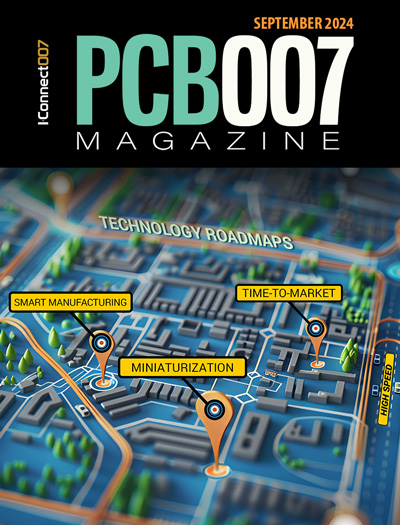-

- News
- Books
Featured Books
- pcb007 Magazine
Latest Issues
Current Issue
Engineering Economics
The real cost to manufacture a PCB encompasses everything that goes into making the product: the materials and other value-added supplies, machine and personnel costs, and most importantly, your quality. A hard look at real costs seems wholly appropriate.

Alternate Metallization Processes
Traditional electroless copper and electroless copper immersion gold have been primary PCB plating methods for decades. But alternative plating metals and processes have been introduced over the past few years as miniaturization and advanced packaging continue to develop.

Technology Roadmaps
In this issue of PCB007 Magazine, we discuss technology roadmaps and what they mean for our businesses, providing context to the all-important question: What is my company’s technology roadmap?
- Articles
- Columns
Search Console
- Links
- Media kit
||| MENU - pcb007 Magazine
TECHNICAL PAPER: Novel Automatic Repair of Populated PCBs in a Cost-effective and Adaptive Way
February 21, 2024 | Essemtec, a NanoDimension DivisionEstimated reading time: 3 minutes
Introduction
Did you ever have to consider repairing an electronic product? Repairing populated boards is getting more and more popular due to several reasons, for example, placement of wrong components, refurbishment or function enhancement of existing products, counterfeit components, etc. The cost of the top five most counterfeited parts represents $169 billion worth of semiconductor revenue. Around 140,000 tons of electronic products are wasted every day globally with few repair options on the market, representing the fastest-growing category of waste in developed countries.
Changing an electrical component is a tedious job. Desoldering it from the board, removing the extra solder from the pads, applying fresh solder and flux to the component or pads, placing the new component, and finally soldering the component again are the typical processes involved. Regarding soldering, there are two ways to perform this process, the first is heating only the affected component locally, and the second is using low-temperature solder, which allows submitting the whole product to temperature. Two main disadvantages of the current repair process are the use of the valuable time of expert personnel and that only one component per product can be replaced at a time. Applying solder paste and placing the component is very problematic, especially on fine-pitch components—the risk of short circuits due to misplacements of packages or solder paste is high.
The proposed method in this work is focused on applying solder paste and placing the component. By using solder jetting instead of printing or dispensing, the time required to deposit solder paste can be significantly reduced. Special needles were designed to perform the jetting process without damaging the already populated components. Another advantage of using a fully programmable jetting system is that the required volume can be customized per pad; for example, pads for a TQFP package with 200 μm width pins and a large pad in the middle can easily be jetted, delivering the correct amount depending on the situation. Pick and place of the components is performed with the same instrument as well in a fully automatic way and the throughput is further improved. The possibility to replace several components on the same product is also given. There is no need for an expert operator once the equipment is programmed.
The repair process has been implemented with different alloys, including SnPb, SAC305, and SnBi. This work presents the results of products reworked using SnPb and SnBi. The results show that the XY positioning accuracy and dot repeatability exceed acceptable expectations for a 400 μm pitch. With this fully automatic jetting and pick-and-place method, the repair of a product can be made in a very accurate and agile way. This represents remarkable cost advantages for companies performing repairing activities.
Experimental Methodology
The experimental studies aim to test the positioning accuracy of the solder deposits as well as the dot repeatability. The throughput achieved with the proposed repair method was also measured. The positioning and dot accuracy was assessed against product needs, and the throughput was compared with the current customer experience. All the accuracy data was collected at Essemtec’s lab, and the throughput data was collected at the customer’s facilities.
Even though every soldered component type can be repaired with the proposed method, this work only analyzed two cases. The first one is a product with a TQFP (thin quad flat package) component requiring a type 6 paste with a Sn63Pb37 alloy. This TQFP has 128 terminals of 200 μm in width with a pitch of 400 μm and a contact area in the middle of 8.4 x 8.4 mm. The size of the TQFP is 14 x14 mm. The second case is a product with a BGA using a low temperature soldering type 6 paste with a Sn63Bi37 alloy. This BGA has a total of 1599 terminals with a diameter of 200 μm and a pitch of 400 μm, the size of the BGA is 18.5 x 27 mm.
A total of 20,000 dots were jetted to verify the stability of the jetting process. For every 1,000 dots jetted on production, 10 dots were jetted on a separate test plate where the dot’s diameter and X-Y accuracy was measured. A total of 200 data points were collected per experiment.
Positioning accuracy and precision together with the dot diameter were measured utilizing the ePlace software which is integrated into Essemtec machines. A normality test was performed on all data using the Anderson Darling method. A capability analysis was performed on every data set using the Minitab software version 19.
Continue reading this paper in the January 2024 issue of SMT007 Magazine.
Suggested Items
ZenaTech Participates in Taiwan Trade Mission to Open First Asian Office for ZenaDrone AI Drone Sensor and Component Manufacturing
11/07/2024 | NEWMEDIAWIREZenaTech, Inc., a technology company specializing in AI (Artificial Intelligence) drone solutions and enterprise SaaS (Software-as-a-Service) solutions, announces that company principals are currently participating in a Trade Mission to Taipei, Taiwan as part of an Arizona Commerce Authority (ACA) delegation, with the goal of opening a manufacturing office for its previously announced Spider Vision Sensors Ltd. subsidiary.
Tresky's Laser- and Photodiodes DIE Bonding in Optoelectronics
11/05/2024 | Tresky GmbHIn the dynamic world of optoelectronics, where light and electronics come together, connection technology plays a crucial role for the performance and lifespan of laser diodes (LD) and photodiodes (PD).
Combatting Advanced Techniques in Counterfeiting
10/30/2024 | Anthony BryantIn today's interconnected global marketplace, counterfeit electronics pose a significant threat to industries ranging from aerospace and defense to healthcare and telecommunications. As counterfeiters employ increasingly sophisticated techniques, the need for robust strategies to prevent, mitigate, and identify counterfeit components has become critical. This article explores the advanced techniques used in counterfeiting, the potential involvement of state-owned enterprises (SOEs), and comprehensive strategies for combating this pervasive issue.
ZenaTech Enters the Drone Sensor and Components Market Establishing a New Taiwan Subsidiary
10/29/2024 | NEWMEDIAWIREZenaTech, Inc., a technology company specializing in AI (Artificial Intelligence) drone solutions and enterprise SaaS (Software-as-a-Service) solutions, today announced it will establish a new company in Taiwan to manufacture drone sensors and components for use in the drone products produced by its subsidiary ZenaDrone.
Yamaha Reveals High-performance AOI Option for High-density and Lighting Assemblies
10/29/2024 | Yamaha IMYamaha Robotics Europe has introduced the YRi-V HS optical inspection (AOI) system with enhanced features for faster performance at high resolution and greater accuracy inspecting surface-mounted LEDs.


